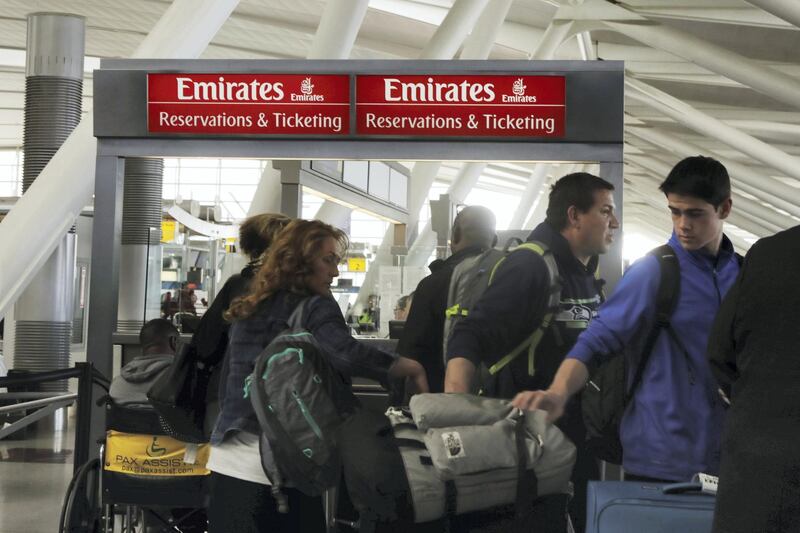It was a turbulent year for the Arabian Gulf and global aviation industry, with a tough start giving way to calmer skies later in the year.
Known as the world’s “super connectors”, the UAE’s carriers Etihad and Emirates faced a series of shocks in 2017 – a cabin ban on electronic devices and the temporary ban on US entry for people from seven Muslim-majority countries hit hard while further afield the bankruptcy of some European investments, along with the emergence of long haul low cost airlines caused waves.
Middle East airlines are expected to post a profit of US$400 million in 2017, a slump of 63.6 per cent compared to $1.1 billion in 2016, although the situation is likely to improve next year. Air travel demand is predicted to grow by 7 per cent in 2018 and Middle East carriers will see net profits improve to $600m in 2018, up from $300m in 2017, according to the International Air Transport Association (Iata).
That will come as a relief to local airlines such as Emirates, who saw its earnings plummet by 82 per cent to Dh1.3bn in the year to March 31. Emirates attributed the results to “heightened concern” in Europe, its biggest market, around “immigration, terror attacks in Brussels, Nice, Berlin, Paris, London” and the political upheaval in Turkey.
But the carrier showed its resilience last month when it reported first-half profit up 77 per cent as the airline cut jobs and benefited from a more stable dollar. Net income increased to Dh2.3bn in the six months ended September 30, with sales advancing 6 per cent to Dh49.4bn.
“The removal of the laptop ban was key and therefore Emirates stands to benefit from high fare paying, higher yielding passengers coming back on to its network and the sharp rise in profits demonstrates that this underlying performance will only get stronger,” said Saj Ahmad, the chief analyst at StrategicAero Research.
“The airline is keen to re-establish some of its double daily flights in the lucrative US market – it’s likely this will happen in the early part of 2018,” said Mr Ahmad.
One local standout was Air Arabia, the UAE’s only publicly listed airline, which reported a 26.6 per cent increase in third-quarter profit.
The low-cost carrier last month said it made a net profit of Dh376m in the three months to September 30, compared with Dh297m in the same period last year, according to Reuters.
Regional airlines are expected to make $1.78 per pasenger in 2017, compared to the global average of $7.6, according to Iata, the airline industry’s trade association. While the Middle East market has kept itself busy, the negatives outweighed the positives for the region in 2017,” said Mark Martin, the chief executive of Martin Consulting in Dubai.
Meanwhile, Abu Dhabi’s Etihad also had a challenging year, as the airline re-evaulated its international acquisition strategy in the wake of the underperformance of some of its subsidiaries amid tough operating conditions. Over the summer, Italy’s Alitalia and Germany’s Air Berlin both filed for bankruptcy, as the UAE carrier decided to stop funding its investments in Europe.
But they were not the only major European casualties this year. In October, the UK leisure carrier Monarch filed for insolvency in Britain’s biggest airline collapse, leaving the government to arrange the return of 110,000 tourists and marking the third failure of a major European operator in five months.
The airline and Monarch Travel were placed in administration, leading to the suspension of the Luton’s operating licence, according to a Bloomberg. Holidays were cancelled and not rescheduled, affecting a further 300,000 people.
The collapse of Monarch, which served more than 40 destinations from five UK bases, employed around 3,000 people and was Britain’s fifth-biggest scheduled airline by passenger numbers. This fall came on the heels of pilot scheduling issues at low-cost rival Ryanair that prompted 20,000 flight cancellations, disrupting travel for around 700,000 customers.
Etihad’s interest in Air Berlin and Alitalia came as part of its decade-long strategy to buy equity stakes in overseas airlines, also including Air Serbia, Jet Airways, Etihad Regional and Virgin Australia. It paid hundreds of millions of dollars in the process. The airline reported $1.9bn loss in 2016 and announced that it was reconsidering its international strategy, announcing that chief executive James Hogan would depart the company.
___________
Read more:
China launches world's biggest amphibious aircraft
Arabian Gulf aviation industry must remain vigilant even after nixing of US tax bill
Strata says delivers first A350 aircraft parts for Airbus
___________
According to Mr Ahmad, it was good that Etihad took the hit early on, so that a new management could start fresh for the next financial year. “The last thing they want is a financial choke-hold around their neck as they look towards moving to the new Abu Dhabi Midfield terminal, which will really help unlock Etihad’s true expansive capability.”
And there was another looming threat for the super connectors, which is likely to grow in 2018. This year the rise of ultra-long-haul low-cost airlines became prominent after a number of carriers started flying across the Atlantic over the summer. Their emergence drove full-service airlines to either lower their prices or start their long-haul low-cost subsidiary.
The trend led to a price war over the summer with Norwegian, formerly Norwegian Air Shuttle, leading the attack by reducing its prices to as low as $69. These aviation disrupters are aided by new generation aircraft that are more fuel efficient. Lower fuel prices is yet another contributor that is making the long-haul low-cost model more feasible.
“Low cost carriers are definitely a concern for Gulf carriers,” said Addison Schonland, founder of the US commercial aviation consultancy AirInsight. “Especially from places like India.”
However, according to Mr Schonland, regional airlines could potentially focus more on cargo to replace the passengers they may lose to the long-haul low-cost revolution. They could also look to purchase hybrid electric models, currently in development by the likes of Airbus, Rolls-Royce and Siemens, and separately Boeing, in the future, as they look for new ways to compete. Still, while low cost carriers could attract Emirates’ low-cost customers away from the airline, the Dubai carrier will keep its premium customers - thanks to its competitively priced premium services.
Globally, low-cost carriers are definitely on the rise. Lufthansa, Air France and IAG, are all growing their new low-cost carrier brands. However, analysts see the lack of comfort and amenities, and the potential risk for passengers, as a setback to the model, particularly on long-haul flights.
“We have seen rising violence on flights because they are just too tight and people explode with anger,” said Mr Schonland.
“We may have reached a limit on tight seating. We expect to see governments to start regulating seat sizes and capacity because of safety concerns. “It takes just one accident with people unable to exit fast enough to demonstrate the folly of too many seats per exit,” Mr Schonland said.
Overall, Iata’s latest economic forecast points to 2017 being the third consecutive year where the global air transport industry generates a rate of return that exceeds its cost of capital. Net post-tax profits of $30bn are expected this year, a little below that of both 2015 and the revised estimate for 2016.
However, the coming 12 months look considerably more rosy. Strong demand, efficiency and reduced interest payments will help airlines improve net profitability in 2018 despite rising costs, Iata said this month. 2018 is expected to be the fourth consecutive year of sustainable profits with a return on invested capital (9.4 per cent) exceeding the industry’s average cost of capital (7.4 per cent).
“These are good times for the global air transport industry. Safety performance is solid. We have a clear strategy that is delivering results on environmental performance. More people than ever are travelling,” said Alexandre de Juniac, Iata’s director general and chief executive.
The year in business: Our biggest stories from 2017








